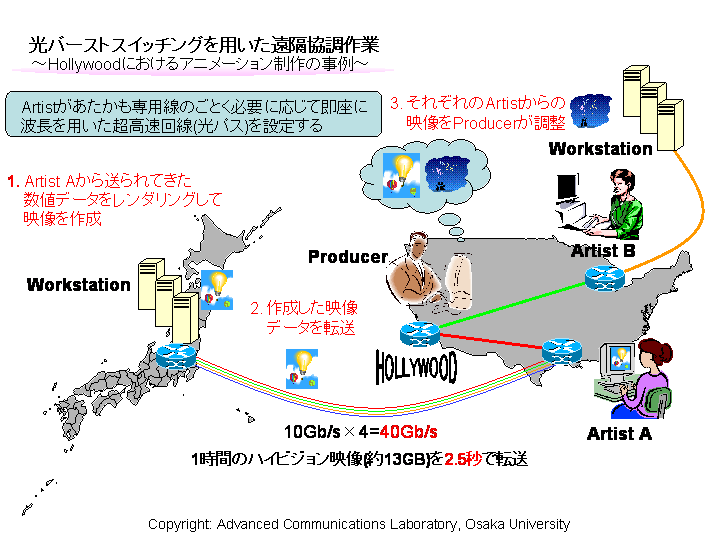 IPオーバーフォトニックネットワーク
IPオーバーフォトニックネットワーク






| 研究内容 | メンバー | 研究業績 | 卒業論文 | 関連リンク | |||||||||||
|---|---|---|---|---|---|---|---|---|---|---|---|---|---|---|---|
 IPオーバーフォトニックネットワーク
IPオーバーフォトニックネットワーク High-functionality photonic nodes
High-functionality photonic nodes
Future photonic nodes must not only forward packets at high sppeds, but also deal with nontrivial issues such as scheduling support for differential services, heterogeneous link technologies, and backward compatibility with a wide range of packet formats and routing protocols. We are studying such a high-functionality photonic nodes for a robust and high-performance networks.
 Optical Burst Switching
Optical Burst Switching
Wavelength division multiplexing has emerged as an important physical layer technology. Optical transmission provides a physical layer capable of carrying bits at the speed of the order of a gigabit per second. Optical burst switching is proposed to overcome the shortcomings of conventional WDM deployment, such as lack of fine bandwidth granularity in wavelength routing and electronic speed bottlenecks in SONET/SDH.

 Photonic add/drop multiplexing (PADM)
Photonic add/drop multiplexing (PADM)
There is the growing demand for high-bandwidth and differentiated data services. In optical data networkings optical add/drop multiplexrs (ADMs) will be key devices at access node. A wavelength add/drop multiplexer (WADM), which enables each wavelength to either add or drop and optically bypass the node electronics, can be exploited toreduce both the transfer delay and the number of electronic digital crossconnect switches and routers. However, WADM is of wavelength granuality, and it can only handle traffic on a wavelength path, and it is unable to handle traffic on a packet-by-packet basis. This may waste the wavelength resource as well as the bandwidth.
Photonic label ADM (PADM) of the finest data granuality of ADMs has been proposed, which equivalently acts as a conventional SONET ADM but at much higher bit rate in optical domain. It has a capability to individually perform add/drop multiplexingfor each optical packet on a single wavelength.
 Photonic Packet Switching
Photonic Packet Switching
In designing and implementing all-optical packet-switched network,
how contention is resolved has great effect on network performance.
In electrical routers contention is usually resolved by using
RAM(random access memory). In optical switch, we have to take different
apporoach because there is no ready-to-use optical RAM. Optical buffers must
be implemented with delay lines, which are fixed-length fibers. We are
studying the optimum technique for buffer architecture.
 Photonic MPLS
Photonic MPLS
Multiprotocol Label Switching (MPLS) is the natural evolution for existing networks to provide the necessary capabilities to support the explosive growth of the Internet, while at the same time enabling network administrators to control traffic at a more granular level. However, as increasing Internet traffic more and more, it is pointed out that a bottleneck in label edge router (LER) in backbone electrical MPLS arises from the lookup of routing table, and it is driving the introduction and evolution photonic MPLS architectures. As the candidates of photonic MPLS, MPλS and the optical code based MPLS (OC-MPLS) are proposed.
 Radio-on-fiber
Radio-on-fiber

光ファイバ無線(Radio-on-fiber: ROF)とは光ファイバの広帯域性を利用して、各種無線サービスの無線変調信号で光を変調し、その光変調信号を光ファイバを用いてに伝送する技術です。伝送された光変調信号は受信側で受光され元の無線変調信号に変換されます。複数の異なる波長の光信号を同時に伝送することも可能です。
従来、電波により伝送されている情報を光ファイバにより伝送する場合、電波の信号波形をデジタル信号に変換して、これを光ファイバ中の光の明滅に対応させて伝送していましたが、電波の信号波形をデジタル信号に変換せずに光の明暗に対応させて光ファイバで伝送することにより、非常に簡単な回路構成で電波信号の光ファイバ伝送が可能となります。